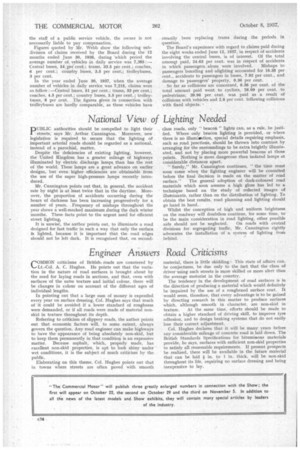Engineer A nswers
Page 60

If you've noticed an error in this article please click here to report it so we can fix it.
Road Criticisms
COMMON criticisms of Britishs roads are countered by Lt.-Col. A. C. Hughes. He points out that the variation in the nature of road surfaces is brought about by the need for laying roads in sections, and that, even with surfaces of the same texture and initial colour, there will be changes in colour on account of the different ages of individual lengths.
In pointing out that a large sum of money is expended every year on surface dressing, Col, Hughes says that much of it could be avoided if a lower standard of roughness were demanded, or if all roads were made of material nonskid in texture throughout its depth.
Referring to criticism of slippery roads, the author points out that economic factors will, to some extent, always govern the question. Any road engineer can make highways to have the appearance of being absolutely non-skid, but to keep them permanently in that condition is an expensive matter. Because asphalt, which, properly made, has excellent non-skid properties, is apt to look shiny under wet conditions, it is the subject of much criticism by the public.
Elaborating on this theme, Col. Hughes points out that in towns where streets are often paved with smooth material, there is little skidding. This state of affairs can, he conjectures, be due only to the fact that the class of driver using such streets is more skilled or more alert than the average motorist in the country.
The tendency in the development of road surfaces is in the direction of producing a material which would definitely be impaired by the use of a roughened surface coat. It would seem, therefore, that every advantage is to be gained by directing research in this matter to produce surfaces which, although smooth in character, are non-skid in texture. At the same time, efforts should be made to obtain a higher standard of driving skill, to improve tyre adhesion, and to design braking systems that do not easily lose their correct adjustment.
Col. Hughes declares that it will be many years before any considerable mileage of concrete road is laid down. The British Standards Specifications for bitnmisous materials provide, he says, surfaces with sufficient non-skid properties to satisfy all reasonable requirements. If present prospects be realized, there will be available in the future material that can be laid in. to 1 in. thick, will be non-skid throughout its life, iequiring no surface dressing and being inexpensive to lay.




























































































